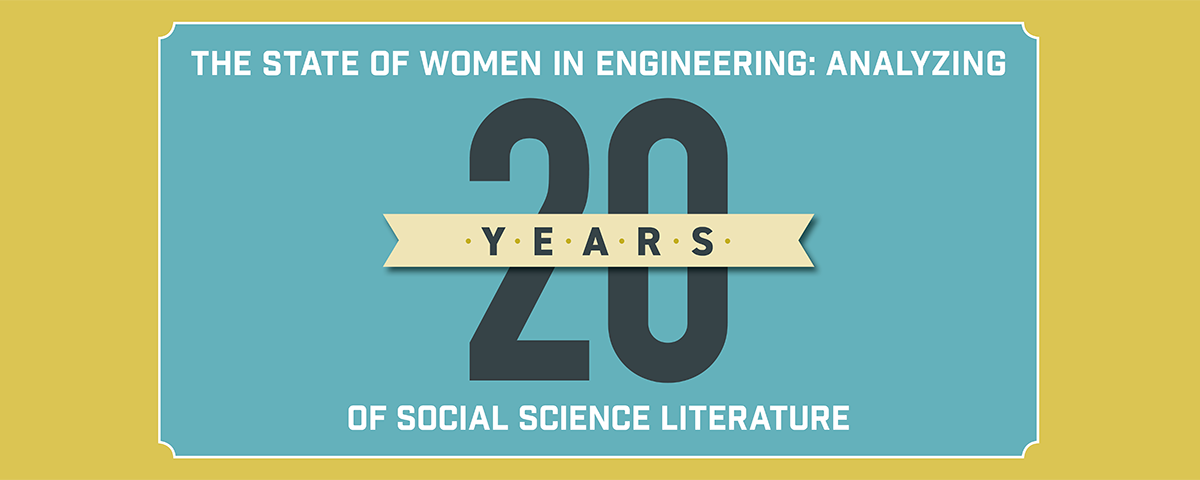
For the past two decades, SWE has conducted an annual review of the social science research addressing the underrepresentation of women in engineering. This retrospective examines what has been learned in that time, what questions remain unanswered, what has changed, what has not, and the policy implications stemming from these realities.
By Peter Meiksins, Ph.D., Cleveland State University and Peggy Layne, P.E., F.SWE, Virginia Tech
In 2001, SWE initiated its annual review of the research literature on women in engineering with a view to making women engineers in industry, the public sector, and the academy more aware of the findings of social science research on the experiences of women engineers and the reasons for the relatively small numbers of women entering the profession. For the past 20 years, the review has appeared in the pages of SWE Magazine, reporting on the growing body of research published each year. Since 2021 marks 20 years of literature reviews, it seems appropriate to look back over previous reviews to try to determine what has been learned and what questions remain unanswered. This retrospective review will also provide an opportunity to assess to what extent and how the situation of women in engineering has changed. Such an assessment will help shed light on whether the many policy changes and innovative programs described in previous years’ research have borne fruit and whether changes “on the ground” have led researchers to shift their focus in response to new realities.
We begin our retrospective look at research on women in engineering with a review of the empirical situation. Has there been progress in increasing the numbers of women in engineering and, if so, how much and in what areas? We then review the main themes on which research has focused over the past two decades, indicating both shifts in research emphasis and ongoing themes that have been central all along. Throughout that review, we will summarize research published in 2021 that made significant contributions to what we know. Finally, we conclude with comments on what a retrospective look at the research literature teaches us about what would be needed to accelerate progress toward gender equity in engineering.
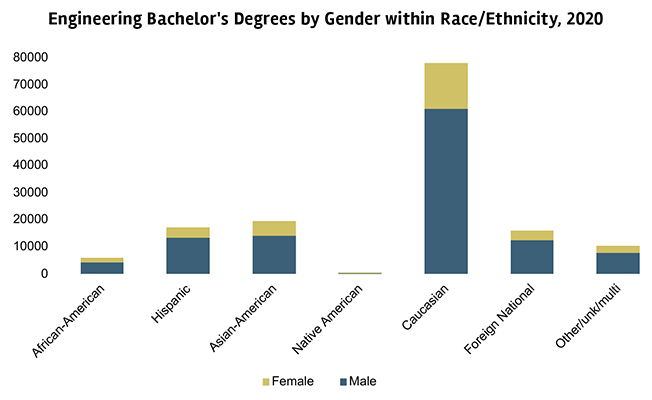
A Review of the Numbers — How Much Change Has There Been?
Reviewing the situation in the early 2020s, one feels a mixture of encouragement that women have become a much more significant presence in engineering in the past few decades and disappointment that the field has not become fully gender-balanced, despite decades of research examining the reasons for gender imbalances, numerous programs designed to attract more girls to engineering, well-funded national programs such as NSF-ADVANCE, and the efforts of important national organizations, including the American Association of University Women and SWE. As the statistical data presented here show, while there has been progress, it has been slow in the 21st century, and women still represent a minority of both engineering students, faculty, and employed engineers more broadly.
One must be careful in interpreting data on the share of the profession occupied by men and women. As previous literature review author Lisa Frehill long ago pointed out, the increase in the percentage of engineering students who were women in the last few decades of the 20th century was as much a function of the decline in male enrollment as anything else — women were not more likely to enroll in engineering programs in 2001 than they had been 15 years earlier.i As engineering enrollments have grown in the last decade or two, there has been increasing interest in engineering among male students, meaning that women’s enrollment would have had to grow even faster for their share of engineering degrees to increase.
That said, the data presented here document real change. First, it is obvious that there has been a significant increase in the share of engineering degrees at all levels going to women. For example, women earned less than 1% of engineering B.S. degrees in 1954; that share had increased to 23% in 2020. Similarly impressive increases occurred for master’s and doctoral degrees in the same period. A bit less encouragingly, however, the most significant increases occurred in the 1970s and 1980s; since 1990, women’s share of engineering degrees has grown, but much more slowly. If trends continue, it will take decades for anything close to gender parity in degree attainment to be achieved.
The percentage of engineering degrees going to women varies by discipline; in 2020, women earned fully half of bachelor’s degrees in biomedical engineering, but only 16.5% of bachelor’s degrees in mechanical engineering. Notably, women’s share of bachelor’s degrees by discipline has been quite stable over the past 20 years. For example, women earned 37% of bachelor’s degrees in chemical engineering in 2002 and 37.7% in 2020; in mechanical engineering, the percentages were 14% in 2002 and 16.5% in 2020.
The share of engineering degrees earned by women varies by race and ethnicity, although not enormously. Among African Americans and Asian Americans, women’s share of bachelor’s degrees in engineering was somewhat higher (closer to 30%), while it was lower for other groups. It should be added that the number of engineering degrees earned by African Americans of either sex was quite small, so one should not exaggerate the significance of the higher percentage earned by African American women.
Data on faculty reveal a pattern similar to that for students. Overall, the share of faculty positions in engineering held by women doubled between 2002 and 2021, from 9.25% to 18.5%. This is an impressive increase, although women still represent a distinct minority of engineering faculty. The pattern of doubling is apparent for most disciplines within engineering, although it remains the case that certain disciplines are less “female” than others — e.g., mechanical and electrical engineering have smaller percentages of female faculty (in the 15% range), while chemical, civil, and biomedical engineering are higher (over 20%). The percentage of faculty who are female decreases with rank: In 2020, only 13.6% of full professors of engineering were women, compared with 25.4% of assistant professors. In one sense, this represents a perpetuation of the situation that prevailed 20 years earlier — in 2002, 4.7% of engineering full professors were women, compared with 17% of assistant professors. It is worth noting, however, that the rate of increase is highest for full professors, so women’s access to senior, tenured positions appears to be improving.
Finally, the percentage of employed engineers who are women also has increased steadily over the past 25 years. In 1993, women represented less than 10% of employed engineers; that percentage had risen above 10% by 2001, when the SWE Literature Review was first published. In the subsequent 20 years, women’s share of engineering employment has continued to grow, rising to about 14% in 2019. It should be emphasized, however, that the rate of growth is very slow, and that women’s share of engineering employment is substantially lower than women’s share of engineering degrees.
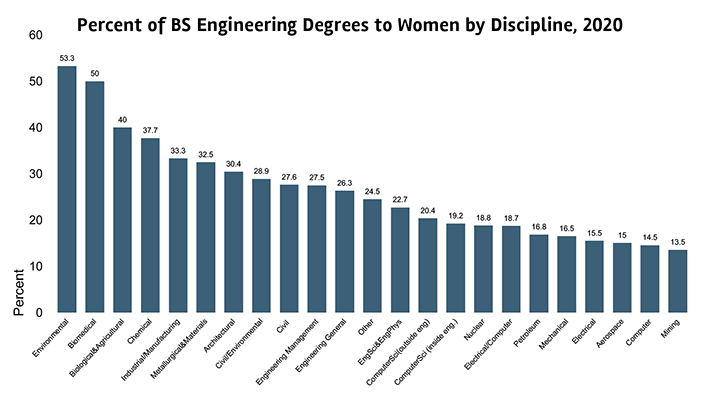
Looking Back at 20 Years of SWE Literature Reviews — What We’ve Learned
Our “meta-analysis” of two decades of literature reviews reveals that much research on women in engineering specifically, and STEM more broadly, has been focused on a finite set of questions. In what follows, we attempt to summarize what has been learned about those questions. We are encouraged to note that, over the years, researchers have learned a great deal about the reasons for women’s underrepresentation in engineering and about the effectiveness (or ineffectiveness) of programs designed to promote change. Although we do not know everything we need to know, and important questions remain unresolved, one can point to a number of significant insights that are now well-established.
It’s Not Just About Math
It was long thought that a primary obstacle to women’s entry into engineering was math achievement. Until the last few decades, girls’ average math achievement trailed boys’ and advanced math classes in high schools (e.g., calculus) were disproportionately male. Since it remains the case that taking advanced math classes in high school is a strong predictor of majoring in engineering, the male/female math achievement “gap” was an obvious explanation for the small numbers of female engineering majors. This appeared so difficult an obstacle to overcome that researchers such as Sally Hacker raised questions about whether calculus was more of a gender barrier than an occupational requirement for practicing engineers.ii
The 2001 literature review still mentioned research showing that achievement gaps in math and science were a factor inhibiting women’s entry into engineering. And, in 2005, the review discussed Lawrence Summers’ infamous comments to the effect that women were less likely to have the aptitudes required to succeed in engineering; in his view, women’s brains were “wired” differently, meaning many lacked the innate ability to succeed in science and engineering.iii In the intervening years, however, research has shown that the gender gap has narrowed, at least in some respects. Although boys continue to outscore girls on standardized math tests of various kinds, advanced math classes such as calculus are no longer dominated by boys (if anything, the reverse may be true), and girls consistently earn higher grades than their male counterparts. Of course, the SWE Literature Review has summarized research emphasizing that there remains a gender gap at the “right tail” of the distribution — that is, boys are more likely than girls to score in the extremely high range of assessments of math ability and achievement.iv Some have argued that this remains a reason for the low numbers of women in engineering because they believe it is high achievers who are most likely to select engineering majors. However, other researchers have shown that boys with mediocre math scores are more likely to enter engineering than girls with very high math scores.v So, it may be that the composition of the “right tail” of the distribution is not the central issue. And, other research finds that girls who are high achievers in math are significantly less likely to choose an engineering major than boys with similar levels of math achievement.vi One possible reason is that high-achieving girls, in contrast to many high-achieving boys, are high achievers in other fields besides math, meaning that they have broader options in choosing a major and career.vii Overall, changes in the nature of the gender achievement gap in math have led to a decreased emphasis in the research literature on the role of math achievement in limiting the numbers of women in engineering.
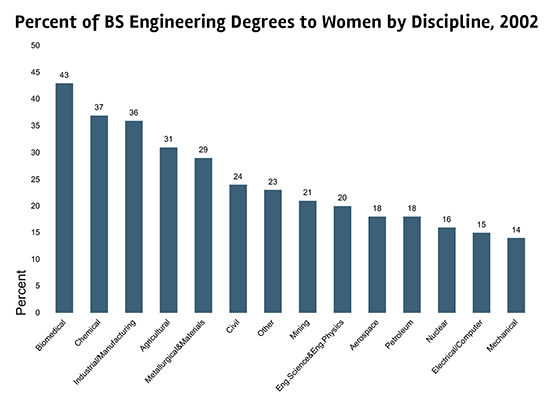
There is, however, another way in which researchers continue to find a relationship between girls’ math experiences and their interest in majoring in engineering. The SWE Literature Review has discussed a large body of research that had begun to develop as early as 2001 focused on whether girls are less confident in math than their male counterparts. With a high level of consistency, research on this question finds that, when compared with boys with similar levels of achievement in math, girls tend to evaluate themselves lower.viii
Whether there is a causal link between this lower self-evaluation and deciding not to major in engineering is somewhat less clear. It seems reasonable to suppose that it may affect girls’ confidence in being successful in engineering and that it may contribute to their feeling that engineering is not for them (a theme we discuss below). However, research published in 2021 found that even girls who hold the counter-stereotypical view that girls are better at math than boys are not more likely to major in physical sciences and engineering, although they are more likely to major in biology.ix
In sum, while substantial research effort has been and continues to be expended on examining whether math and/or confidence in math affect girls’ interest in majoring in engineering, the relationship among math achievement, math confidence, and interest in engineering appears to be, at best, complex. It is perhaps time to agree with a study by Isaacs, summarized in the very first SWE Literature Review, that argued that “recruiting efforts directed toward encouraging girls to study math and science are focused on the wrong problem.” (4)x
Not All Women Are the Same
Research on women in engineering has introduced the term intersectionality to capture the reality that talking about “women in engineering” as if all women shared the same experiences is a serious mistake. The SWE Literature Review has discussed a growing body of research that details the ways in which a woman’s race or ethnicity can affect her experience in engineering, the ways in which sexual orientation can matter and, most recently, the different experiences of female engineers with disabilities. There has been far too much research to summarize it all adequately here. A few examples of the kinds of insights attention to intersectionality has yielded will have to suffice.
Research published in 2021 illustrates well the value of attending to the different experiences of female engineers of different races and ethnicities. Cross et al. (2021) describe the fact that female students of color face a “double bind” in which they are continually required to dispel negative stereotypes based on their group association (i.e., both their race/ethnicity and their gender) and to defend their presence within the engineering culture.xi True-Funk et al. (2021) conducted a set of interviews with a diverse group of engineering undergraduates, documenting their experience of microaggressions and finding a variety of intersectional effects — the consequences for African American women differed somewhat from those for African American men, differed again from the effects on Latina or Latino students, and so on.xii Interestingly, True-Funk et al.’s research, like a small-scale interview study (Ross, Huff, and Godwin 2021) of nine successful, senior engineers of color (all had been in the field for at least 10 years), found that African American women, despite the “double bind” they faced, were able to make their racial identity into a strength and to find ways to make it congruent with their identity as engineers.xiii
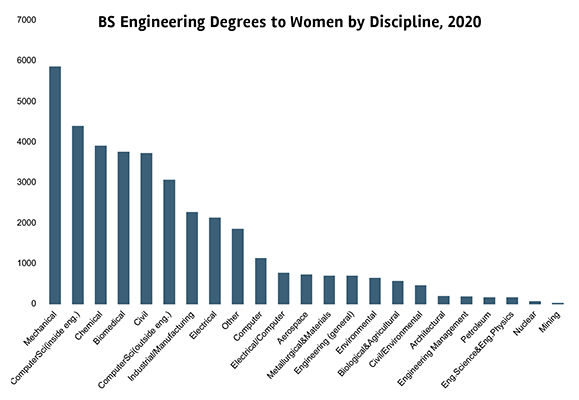
Earlier research described in the literature review emphasized the need to tailor recruitment efforts to the different experiences and situations of students of color. For example, efforts to increase the number of female students of color need to address those students’ desire to help their communities and take advantage of the peer support groups students themselves form and on which they rely. Efforts to recruit them also need to recognize that they are likely to attend schools that don’t support the students’ language and culture (thus weakening their resilience) and are less likely to provide them with the math and science instruction they need to succeed in engineering. Recruitment efforts also need to recognize that many students of color begin their educations in two-year institutions and make an effort to build pipelines from those schools to four-year engineering programs.xiv Sexual orientation has been identified as another axis of intersectionality affecting women in engineering. Yang et al. (2021) report on a focus group study of nine LGBTQ+ engineering students at a large public university in the Southeast. Their respondents report feelings of isolation (even if there were other women in their classes), the need to respond continually to homophobic comments and behaviors, and how they deliberately sought out institutional roles (such as being a TA) that would enable them to help other LGBTQ+ students find the resources they needed.xv Finally, an interesting study reviewed in 2017 noted the ways in which gender, sexual orientation, and race all intersected to produce a range of different experiences for female engineers. The 18 tech workers in the Bay Area all reported struggling to fit into the male “geek culture” that shaped their workplaces. However, their identities affected their ability to succeed. White women whose self-presentation was “gender fluid” and who identified as LGBTQ were better able than others to manage their status on male-dominated teams. Race mattered, however, as black LGBTQ women were not as successful.xvi
These are merely a few examples of the many interesting insights produced by a focus on intersectionality. What this research illustrates is that a “one-size-fits-all” approach to promoting gender equity in engineering is unlikely to be successful. Happily, a retrospective look at the SWE Literature Review demonstrates that researchers and advocates for gender equity in engineering have become increasingly aware of the need to understand and take into account the differences among the many kinds of women in engineering.
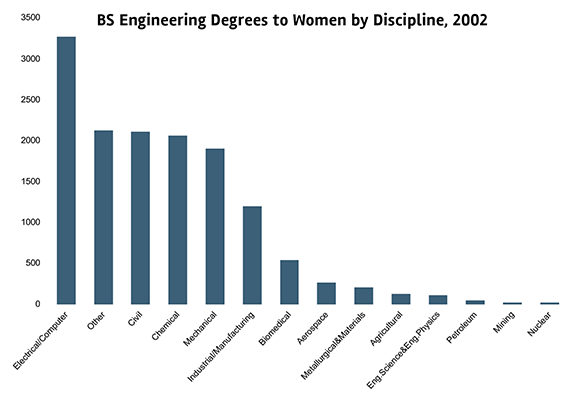
Recruitment Needs to be Combined with Retention
The “leaky pipeline” metaphor has been criticized for oversimplifying the process by which women make their way into and progress through engineering careers. However, researchers acknowledge that it is important to examine not just which methods of recruitment promise to increase the numbers of women in engineering, but also what needs to be done to ensure that they remain. If large numbers of women leave the profession at some point during their life course, even the most vigorous recruitment efforts are likely to have little effect on engineering’s gender balance.
One could argue that there is a sense in which girls leave the profession before they even enter it! Research reviewed in 2020 found that both male and female students’ interest in STEM declined during the high school years, but that girls’ interest in science and engineering tends to decline much faster.xvii Since the numbers of girls with engineering intentions are small to begin with, this pattern of decline is an obvious reason for the underrepresentation of women in college engineering programs.
There has been much discussion of the retention of women in college programs. Many studies describe the fact that some female students leave engineering majors, but many of these studies, including some of the most carefully donexviii, don’t include male students in their analysis. Since male students leave engineering majors too, it would be necessary to show that women leave at higher rates than men to argue that the gender gap is the result of female attrition.
Whether women leave college engineering programs at higher rates than men has been much disputed. Lisa Frehill, who led the SWE Literature Review project for most of its first decade, stated clearly in a 2010 publication that they did notxix Subsequent editions of the literature review have discussed a number of research studies of this question, but there continues to be no clear consensus as to how to answer it. In 2016, the review cited a meta-analysis of the research on attrition by Cheryan et al. that asserted strongly that recruitment, not retention, was the reason for the gender gap in engineering.xx Much of the subsequent research reviewed by SWE has been consistent with that conclusion, but occasional studies appear that continue to find evidence of a gender gap in retention. For example, research on major-switching published in 2021 found that women switched majors more frequently than men and were more likely to switch out of STEM majors.xxi A comprehensive national study of this issue may be needed to resolve the debate.
There is a higher level of consensus that women leave engineering after graduating at higher rates than men, especially since the percentage of engineering degrees earned by women is substantially higher, consistently, than the percentage of employed engineers who are women. There is somewhat less certainty as to why this attrition occurs, in part because of the limited amount of research being conducted on the experiences of working engineers. However, a number of possible reasons have been suggested.
Among the leading explanations of women’s leaving engineering careers at higher rates than men involves work/family conflict. At least since the pioneering publication in 2004 of Anne Preston, Leaving Science,xxii researchers have emphasized how women find the time demands of engineering and scientific careers difficult to reconcile with their domestic responsibilities. Major studies by, among others, Fouad and Singh and Cech and Blair-Loy have documented further the effect of work/family conflict on women’s persistence in engineering.xxiii Failing Families, Failing Science, a book on the issue published in 2016, did make the case that growing numbers of men also struggled with the time commitments required by careers in academic STEM, but it still acknowledged that women were more affected by work/family conflict than men.xxiv
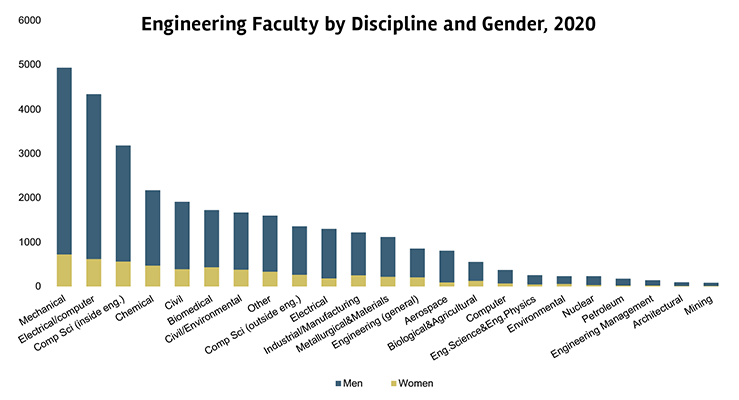
Other research questions the centrality of work/family conflict to women’s departure from engineering careers. An important example is SWE’s own study of why women leave engineering, the results of which were published in an issue of SWE Magazine in 2016.xxv This study found that work/family balance was not the primary reason for women’s leaving. Instead, women left because they found themselves working in environments that tolerated persistent obstacles to their organizational and career goals. Fouad and Singh’s research, while emphasizing work/family conflict, also noted that female engineers often left because their career goals were not being met.xxvi
An interesting study published in 2021 points to a possible reason why work/family conflict may not play as central a role as might be thought in causing midcareer women to leave engineering. Thébaud and Taylor (2021) conducted interviews with 57 postdocs and doctoral students in science and engineering, 2/3 of whom were women. Their respondents described a “specter of motherhood” in which motherhood was constructed in opposition to professional legitimacy, as something to fear. Female students and faculty (but not men) felt compelled to conceal motherhood and to choose between motherhood and career.xxvii This analysis suggests that some women may be leaving engineering before they embark on careers or that they find ways either to avoid motherhood or to subordinate it to the careers to which they have committed.
Finally, many have mentioned women’s experience of the masculine culture of engineering as a reason for their departure. The SWE Literature Review has discussed numerous publications describing that culture and some women’s unwillingness to adapt to it (more on the masculine culture of engineering below). While much of that literature takes the form of anecdotal accounts of personal experiences, two well-conceived studies of the early-career experiences of female engineers show how male culture can push women away. Seron et al. (2016)xxviii studied a group of engineering students at four New England universities, finding that their experiences in internships and team projects already involved gender stereotyping that affected their enthusiasm for engineering careers. The 2016 literature review quoted that study as follows:
“The findings reported here suggest that subtle and cumulative encounters with the values and norms of professional culture compromise women’s affiliation with the profession and raise the prospect of departure.” (pp. 30–31)
In 2018, the literature review discussed a fascinating study by Wynn and Correll involving observation of recruiting sessions by technology companies at prominent West coast universities.xxix These recruiting sessions were consciously planned to recruit female candidates, but the study found that the primary presenters were generally male and that the presentations involved frequent (positive) references to the workplaces’ fraternity-like cultures and to aspects of pop culture more likely to be of interest to men. Without intending to, the sessions may have been pushing women away from careers in technology.
In sum, while many questions remain about the timing of and reasons for women’s departure from science and engineering, researchers have demonstrated clearly that retention, not just recruitment, is an important cause of the underrepresentation of women.
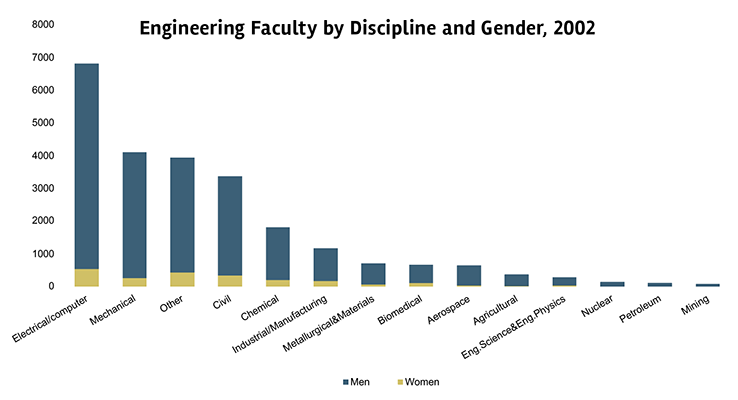
Well-Funded, Sustained Programming Works — the Case of NSF-ADVANCE
The 2002 SWE Literature Review announced the initiation of NSF-ADVANCE, a federal program designed to support efforts to increase the numbers of female faculty in science and engineering, and noted that the first nine grants had been made. A new cohort of 10 projects was announced in the 2004 review. Since then, the literature review has regularly featured descriptions and assessments of individual NSF-ADVANCE projects as well as a number of overviews and analyses of the program as a whole.
These analyses of NSF-ADVANCE projects have, by and large, been positive, and it is clear that the work done in the various individual projects has gradually accumulated into real collective knowledge about the experiences of female faculty in STEM departments and about what works (and what does not) in supporting efforts to improve the recruitment and retention of women in academic STEM. Early assessments of NSF-ADVANCE projects emphasized the now familiar idea that departmental climate is important to both male and female faculty and that the impact of a toxic climate was greater on women.xxx Research summarized in 2010 identified a number of problems associated with traditional searches and techniques to overcome them, many of which have become standard practices in universities across the country.xxxi In 2012, the review discussed a book by Bilimoria and Liang that assessed the results of the first two ADVANCE cohort projects; that assessment was largely positive and emphasized that the programs’ success was rooted in their having senior administrative support and involvement, the presence of an institutional champion, collaborative leadership, widespread and synergistic participation across campus, and the existence of visible actions and outcomes. Bilimoria and Liang also noted that a network of peer institutions had developed through ADVANCE and that the funding provided by NSF gave the programs legitimacy.xxxii Many more assessments of individual projects echo the conclusion that ADVANCE projects have had a significant impact on the institutions where they were implemented. An article published in 2021 even argued that a concept as important and ubiquitous as “implicit bias” took root in the broader corporate world largely because of pathbreaking work in projects supported by NSF-ADVANCE.xxxiii
The SWE Literature Review has discussed some criticisms of NSF ADVANCE. An assessment by Morimoto and Zajicek reviewed in 2014 noted that ADVANCE programs can be too focused on individuals (through mentoring programs and the like) and that they often rely on women to become the changemakers.xxxiv Zippel and Ferree, while praising ADVANCE in many respects, note that it has been limited in some ways by its need to balance the conflicting priorities of gender equity, organizational priorities, and the norms of scientific publication.xxxv Still, despite these criticisms, a re-reading of the research on NSF-ADVANCE discussed in the SWE Literature Review indicates that it has been a successful program that has had a significant impact on diversity in academic science and engineering. While it would be wrong to conclude that the growing share of academic positions in STEM held by women is entirely the result of NSF-ADVANCE programs, it also is obvious that the knowledge generated by ADVANCE projects has had effects well beyond the institutions at which they were implemented and has helped to spur the gradually increasing diversity of the STEM professoriate. NSF ADVANCE demonstrates that change can be promoted by well-funded national programs that combine good research with strong, internal support for sustained institutional transformation.
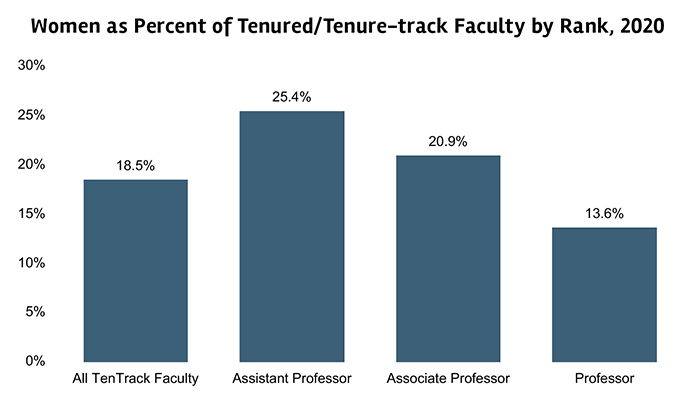
An Ongoing Debate
Thus, 20 years of research on women in engineering has resulted in real knowledge and in the exploration of new research questions — our understanding of the situation of women in engineering has definitely advanced. Yet, there is a sense in which the arguments reviewed in 2021 would seem familiar to someone living in 2001. Specifically, researchers continue to be divided on the question of whether efforts to increase the numbers of women in engineering should focus on better preparing women for engineering as it currently exists, or whether gender equity in the field requires that engineering itself change in some way. In 2001, the year in which the first SWE Literature Review was published, Pamela Mack wrote an article titled “What Difference Has Feminism Made to Engineering in the Twentieth Century?”xxxvi She noted the question identified above, and concluded that, for the most part, researchers and program designers were not focused on changing engineering itself:
“Rather than tackle subtle prejudice head on, studies of how to encourage more women to study engineering came to emphasize networking, mentoring and career development programs.” (p. 159)
While the most popular strategies for encouraging women to study engineering have changed somewhat in the past 20 years, Mack’s 2001 assessment could easily be applied to the situation in 2021. As our “meta-analysis” reveals, the relatively slow progress toward gender equity in engineering continues to fuel calls for a focus on structural changes, not just supporting individuals.
Why Aren’t Girls More Interested in Engineering and What Can Be Done About It?
A large portion of the research reviewed in SWE’s Literature Review each year focuses on girls and women themselves: What do they think and what do they want? The hope seems to be that, if we can understand the psychological and motivational barriers to girls’ involvement in engineering, we may be able to strengthen them in areas where they may be weak as potential engineers and to persuade them that they can fulfill themselves in the field. Research has shown that girls’ and boys’ interests develop early in life, so the focus has been on girls’ development and experiences prior to their entering university.
Young girls’ lack of knowledge about and experience with engineering is one recurring theme in research on their interest in the field. Researchers find that girls know relatively little about engineers and engineering, and that what they “know” is sometimes incorrect. For example, Salas-Morera et al. (2021) report on research in which they asked a sample of high school students whether engineers perform various tasks — some of the students were wrong, with more girls than boys being misinformed.xxxvii Girls have little contact with the field and are unlikely to have encountered female engineers whom they can emulate or from whom they can learn. Toys designed for girls typically do not encourage the development of the kinds of skills associated with engineering (building, tinkering, electronics, etc.) and parents are less likely to see their daughters as possessing the skills and inclinations that lead toward engineering, so they are less likely to encourage girls than boys in that direction.xxxviii All of this would seem to suggest that exposing girls early to engineering might help. But, as Cheryan et al. have noted, some fields where girls also do not have early exposure are actually female-dominated, so early experience alone may not be the solution.xxxix
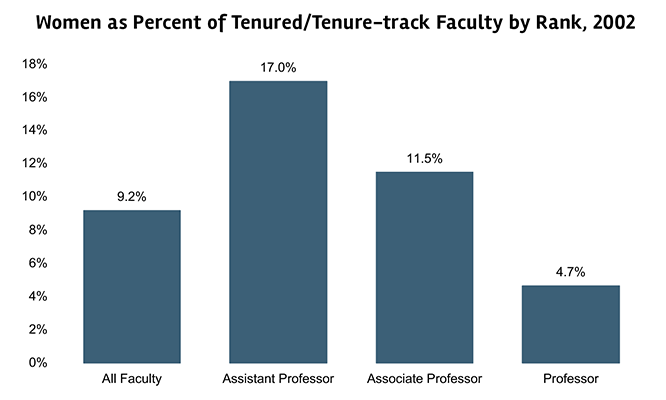
Still, engineering continues to be perceived by both children and their parents as “masculine,” as a field dominated by men and to which men are better suited than women. When Americans, both male and female, are asked to describe an engineer, they are much more likely to describe a man, a fact which affects young girls as well. One study reviewed in 2018 found that even incoming female undergraduate engineering majors viewed the “typical” engineer as stereotypically masculine.xl While this did not prevent these women from choosing to major in engineering, it seems likely that this stereotype is a factor steering other women away from the field. And, researchers have found that boys are particularly tenacious in defending gender norms, policing gender “deviants” strictly and aggressively claiming particular kinds of tasks as belonging to boys.xli
Researchers find that the perception that engineering is “male” affects girls’ sense of belonging in the field, meaning they are less likely to aspire to a career in engineering or to persist in pursuing engineering studies should they begin. For example, Veldman’s 2021 study of a sample of Belgian high school students in STEM-focused university tracks found that girls’ concerns about “belonging” were significantly higher in fields (such as engineering) that are heavily male-dominated.xlii
Many Americans also link engineering and masculinity through the perception that being successful in the field involves “brilliance” and that brilliance is a quality that boys are more likely to have than girls. The SWE Literature Review has discussed numerous studies documenting the male-brilliance-engineering association, including one that found it developing very early — among children as young as 6!xliii The 2020 review included a sidebar on Lisa Piccirillo, a mathematician who solved what had been seen as an insoluble math problem and has subsequently spoken out against the perception that innate brilliance is a requirement for success in math-intensive fields.
Researchers also have argued that girls have different interests and career goals than boys and that engineering typically does not present itself as a good field in which to pursue those interests and goals, even though it could easily make that case. In 2015, the literature review reported on Su and Rounds’ meta-analysis of gender differences in interest as an explanation of the underrepresentation of women in STEM; it found that most studies confirmed that women were more interested in people-oriented than object-oriented fields, so disciplines such as engineering were seen as less attractive.xliv
Even studies of engineering majors seem to confirm the argument that young women are attracted by different aspects of a field than men. Erin Cech’s study of undergraduate engineering students at four universities in the Northeast found that women’s self-concepts led them to value social consciousness more and to be less likely to value technological leadership.xlv Similarly, Patrick, Riegle-Crumb, and Borregoxlvi report this year on a study of a sample of engineering students at a large public university in the United States, finding that men identified with engineering more strongly than women and that men identified with different aspects of engineering than women did. However, not all research confirms that differences in interest explain the failure of engineering to attract more female students. In 2019, the review discussed several research studies examining whether male and female students’ interests differed.xlvii A number found that they did — women were found to be more people-oriented, interested in solving social problems, and altruistic. But another study found that it was quite common for both male and female STEM students to major in disciplines that did not align with their stated interests.xlviii
The overall effect of this type of research is to underline the fact that girls need to be recruited to engineering, while boys do not. Simply improving girls’ math and science skills is not enough. Girls (and their parents and peers) need to be persuaded that engineering is for girls as well and that they can pursue their interests and career goals in the field. So, what do researchers and policymakers think might work?
One common suggestion is that having more female role models would help. The hope is that if girls have contact with more female engineers and encounter more women as they proceed through engineering programs, they will be more likely to aspire to engineering careers and persist in engineering programs and less likely to avoid the field because it seems male-dominated. Over the years, the SWE Literature Review has discussed numerous accounts of programs designed to bring young women into contact with female engineering role models, but the results of these programs vary, so the jury is still out on how effective they can be in increasing girls’ interest in engineering.
Mentoring also is often mentioned as a strategy for increasing the numbers of women in engineering — here the emphasis is on retaining interested female students rather than recruiting the reluctant. Early issues of the literature review contained frequent reference to this strategy, including extended discussions in both the 2006 and 2008 reviewsxlix. And, studies of the efficacy of mentoring and calls for expanded and improved mentoring for women at all stages of engineering careers continue to appear. There seems to be a consensus that effective mentoring helps women who enter engineering to persist and succeed, although the 2009 review summarized an article in Research in Higher Education that identified expanded mentoring as one of the “least successful” programs for undergraduate women in engineering.l However, researchers continue to examine questions such as whether female or male mentors are preferable, whether formal or informal mentors are more effective, whether women seek the same kind of mentoring as men, and how to avoid the reality that mentoring experiences can also be negative.

Some efforts to combat the perception of science and engineering as male focus on trying to strengthen girls’ science or engineering identity. It seems logical to argue that, since, on average, girls identify less with science and engineering than boys, strengthening that identity would increase the likelihood that girls would enter and persist in engineering and science programs. Research has raised questions about whether a successful effort to do this will actually help. A study reviewed in 2020 found that science identity was more strongly associated with science aspirations for boys than for girls.li The fact that girls with strong science identities were less likely than comparable boys to aspire to science careers challenges the view that targeting girls’ identities alone will increase their desire to pursue careers in science or engineering.
Perhaps the way to counter the cultural association of engineering with masculinity is to present engineering differently. As we have seen, many researchers focus on the idea that girls have different interests and aspirations than boys and that engineering needs to do a better job of appealing to them. Some have suggested that a good way to do this would be to expand programs that already appeal to more women, such as environmental or biomedical engineering. However, research indicates that doing so tends to have the effect of drawing women away from other subdisciplines rather than increasing the numbers of women overall; it may even have the effect of hardening gender stereotypes within engineering, as fields such as mechanical or electrical engineering become even more male-dominated.lii
Researchers also have found varying answers to the question of whether engineering enables women (and men) to satisfy their “agentic” or communal goals. Some find support for the idea that engineering can be presented as a career in which such goals can be met, but others respond that it doesn’t always do so. In either case, it is important to take note of a study discussed in the 2018 review, which criticized what some see as cosmetic innovations in engineering’s self-presentation; women are not likely to be persuaded to enter or to remain in the field if promises of a different approach are not sustained throughout engineering programs and careers.liii
Finally, researchers have shown that there is a need to be cautious in assuming that there is a simple relationship between individuals’ stated goals and interests at a point in time and their career choices. As we saw above, there is evidence that many people in STEM fields have stated interests different from those associated with the careers they chose. And, other research has found that people adapt to the goals and values of the careers they select — women, in particular, may find that emphasizing communal goals is at odds with the prevailing male culture of engineering, so downplaying those goals and assimilating to traditional engineering culture may be viewed as a prudent career choice.liv
Fix the System, Not the Women — What’s Pushing Women Away?
Pamela Mack’s 2001 analysis cited earlier argued that efforts to recruit girls and young women to engineering tended to focus on changing women — by educating them about the field, by persuading them that it offers them opportunities to fulfill their goals, and by strengthening their science and engineering identities. Over the succeeding 20 years, as the above review indicates, that emphasis has continued to inform much of the research on gender inequity and programmatic efforts to increase the numbers of women in the field. But, Mack’s analysis noted that there is another way to approach the problem — perhaps it is engineering itself, and not just the women it seeks to attract, that needs to change if it is to become a field to which similar numbers of men and women are drawn. That approach has also continued to inform the work of some researchers and program designers, as the limits of focusing exclusively on women became apparent.
Educated women in the United States have choices about which careers to enter; the evidence is that many of them are choosing more gender-integrated occupations. Pearlman’s (2019) research showed that women are gravitating toward expanding opportunities in areas such as management, rather than trying to enter occupations that have been historically male-dominated, such as engineering.lv While she leaves open the question of whether women have a negative view of fields such as engineering, the reality that they can choose easy-to-enter, growing areas of employment, rather than overcome historical barriers to entry in engineering, tips the balance away from the latter. And, researchers have also found evidence that some young women perceive engineering not just as male-dominated, but as gender-biased. Studies summarized in the 2018 review found experimental evidence that women react negatively to fields in which they perceive bias and survey evidence indicating that college undergraduates, while not averse to STEM majors as a whole, perceived specific STEM fields (including engineering) as biased and were likely to avoid majoring in those fields for that reason.lvi
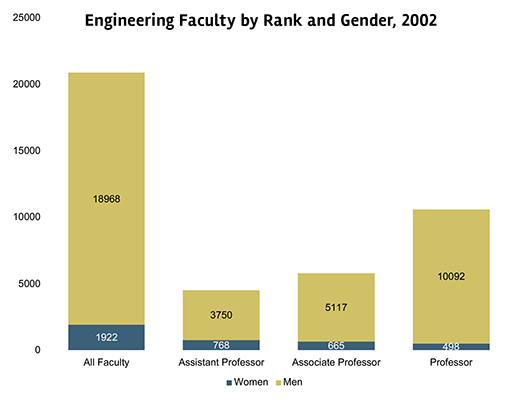
Other research suggests that this perception is not simply an invention — considerable evidence exists that engineering can be an unwelcoming field to women who seek to enter. Studies of this problem have focused on two questions: a. Do female engineers face bias in hiring and promotion decisions and b. Is there a “chilly climate” for women in engineering workplaces?
Whether there is bias in personnel decisions has become the subject of much controversy. Research conducted by Ceci and Williams (2014) contended that there is little evidence that women face employment discrimination in math-intensive STEM fields in universities. According to this research team, female candidates are at least as likely as males to interview for tenure-track positions; they also found that reviewing for grant funding and manuscript submission are gender-neutral.lvii These findings attracted substantial public attention as a result of an op-ed the authors wrote in The New York Times summarizing their research and a vigorous response in the same newspaper from critics.lviii
Subsequent research continues to be divided on the issue of whether discrimination exists in engineering employment. A 2017 study of actual job interviews suggested that simply examining who gets interviewed is not enough; it found evidence that female job candidates who made it through to the interview stage faced different, and more intense kinds of scrutiny than male candidates for the same positions.lix Research discussed in the 2020 literature review presented conflicting findings. On the one hand, one study found evidence that female doctoral recipients in several fields, including engineering, were more likely than male doctoral recipients to receive no job offer after completing their degree. Experimental research using matched resumés for male and female candidates found evidence of implicit bias in male-dominated physics, but not in more gender-integrated biology (suggesting something similar may be the case in engineering). However, a study of university faculty found that engineering faculty, in particular, when asked to recommend colleagues for various roles, were more likely to recommend female candidates for leadership and research roles. The study’s authors speculated that this may reflect a degree of “bias correction” in a male-dominated field.lx
All of this research focuses on academic employment, but a study published in 2021 suggests that, outside the academy, hiring and promotion decisions may be shaped by the interaction of women’s choices and implicit biases. Campero (2021) analyzed data from a hiring platform to examine the development of gender segregation in software engineering and development. He found that women are more prevalent in lower-paid, lower-status quality assurance positions in the field. This was largely the result of women’s being more likely than men to apply for these positions; but, employer bias also played a role, in the sense that people employed in quality assurance roles were less likely to be considered subsequently for better-paid roles in other areas.lxi
The perception that employed female engineers confront a “chilly climate” in their workplaces has also been the subject of much discussion in recent years. The SWE Literature Review has discussed the growing number of published accounts of what it is like to be a woman employed in a high-tech firm. The picture that emerges is one of a “bro culture” in which sexist behavior is tolerated and in which women are subjected to a variety of indignities, microaggressions, and unequal treatment.
Lacking detailed studies of other engineering workplaces, it is impossible to say whether the conditions in the tech industry are characteristic of other engineering workplaces. However, there are at least some indications that women encounter microaggressions and sexism in a variety of engineering employment settings. We have already discussed Seron’s study of the internship and work team experiences of engineering students. Research on teams in engineering has been reviewed on numerous occasions in the pages of the literature review, consistently finding that women are not treated equally when they find themselves on teams dominated by men. Research reviewed this year leads to similar conclusions. For example, Tomko et al.’s (2021) study of university maker spaces finds that female students encounter obstacles to entry and are treated as “helpless” females by their male counterparts.lxii Beddoes’ (2021) study, based on interviews with a small number of newly hired female civil engineers, finds that they identify a variety of forms of male privilege in their workplaces, notably being taken seriously, not being subject to sexual harassment, and feeling welcomed.lxiii
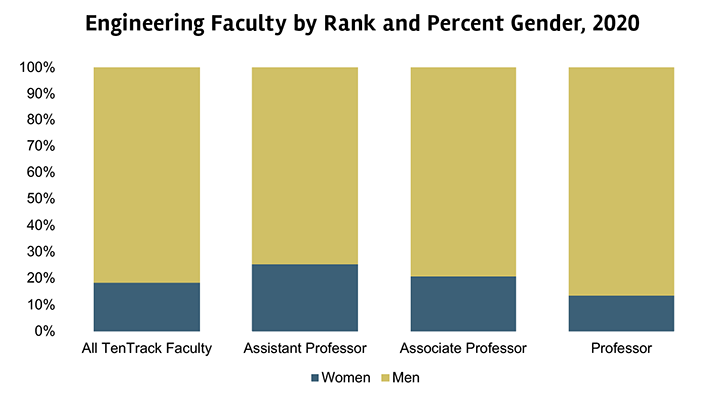
Developing strategies to address the kinds of institutional and cultural problems these studies investigate is obviously challenging. Complicating the problem is the reality that many people, both men and women, don’t acknowledge that there are structural problems involved.
Although, as some critics of NSF ADVANCE have noted, women are often cast in the role of change-maker in programs designed to modify institutional cultures; researchers have found that many female engineers are reluctant to say that sexism and bias are more than an individual matter. One of the first studies along these lines discussed in the literature review was Britton’s (2017) analysis of a set of interviews with about 100 female STEM faculty at public research universities. Her respondents reported incidents of unfair and unequal treatment at work, but they did not describe them as part of a broader “chilly climate.” Instead, perhaps concerned that to do so would draw additional attention to their gender and worsen the situation, they preferred to treat these incidents as isolated cases of individual misbehavior.lxiv
Subsequent research confirms this finding. Seron’s (2018) study of undergraduate students emphasized their resistance to identifying themselves as a “feminist.” While acknowledging their marginalization as women in a male-dominated field, they attributed their success to individual effort and accepted the prevailing meritocratic interpretation of the field. To them, improving women’s situation in engineering was not a matter of structural changes but of strengthening individual women’s skills so that they could more effectively compete in a field they saw as largely gender-blind.lxv A number of studies summarized in the 2019 review painted a similar picture of the attitudes of female engineers and scientists, which one referred to as “STEMinism.”lxvi
Research published in 2021 continued along the same lines. The eight women who held engineering leadership positions in Germany studied by Schmitt (2021) believed that succeeding in the profession required adapting to the male “habitus” of engineering. Although conscious of gender inequality in the profession, all reported trying to stay invisible as women in order to maintain their identity as an engineer.lxvii Somewhat more encouragingly for advocates of institutional transformation, Bird and Rhoton’s (2021) study of a group of faculty involved with NSF ADVANCE found that there was a range of opinions among their respondents about whether STEM disciplines were meritocratic; faculty in departments in which women were in a significant minority (such as engineering) were more likely to see systematic problems. Bird and Rhoton speculate that the fact that these were ADVANCE institutions may have increased faculty members’ awareness of institutionalized inequalities.lxviii
Studies such as these indicate that institutional transformation requires that female engineers be persuaded that it is actually necessary. Researchers also have argued that it is important to persuade men, since it is their attitudes and behaviors, and the structures they have built around them, that need to be transformed. And, male scientists and engineers, like their female colleagues, tend to see their disciplines as gender-blind, as Sattari and Sandefur’s (2019) study of male STEM faculty indicated.lxix Even sympathetic male colleagues may see men playing a relatively limited role in institutional change. The same study found that leaders (largely male) expected men to make largely attitudinal changes (“be more sensitive”) while they expected women to change more fundamentally (be more aggressive, reconsider family commitments). It is worth adding that even the expectation that women should be more aggressive is not really a commitment to institutional change. As a recent study of the concept of implicit bias and its role in NSF ADVANCE has noted, while it is important and useful to press for change in the attitudes of individual members of an organization, doing so does not affect the structures surrounding those individuals and may render the attitudinal changes ineffective.lxx
Last year’s SWE Literature Review highlighted a recent book by David G. Smith and W. Brad Johnson entitled Good Guys: How Men Can Be Better Allies for Women in the Workplace. The book makes a strong case that men need to be part of the solution to the problem of institutional gender bias in the workplace and identifies a number of concrete ways in which they can help. However, as SWE’s summary observed, the likelihood of men’s playing a leading role is limited by the fact, discussed above, that many men (and women) don’t perceive their institutions as sexist and by the reality that many men may see women’s gain as their loss.lxxi
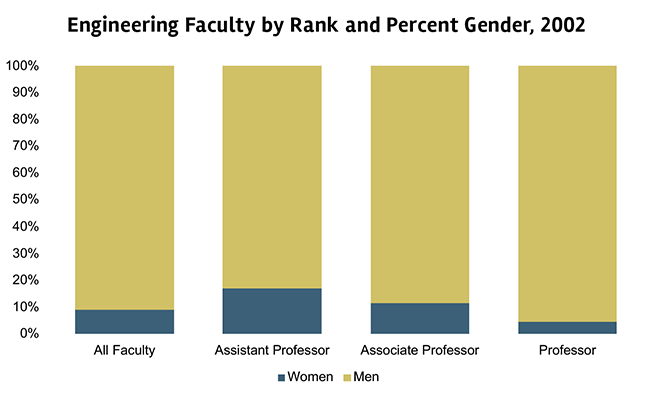
CONCLUSION
Achieving equity in occupations dominated by one sex is difficult. As the classic analysis of the issue by Barbara Reskin and Patricia Roos demonstrated years ago, it is extremely rare to find an occupation in the United States in which men and women work alongside one another in equal numbers performing the same tasks.lxxii We should, therefore, be impressed that women have made the significant strides in engineering the data presented at the beginning of this review document. At the same time, it is reasonable to ask whether ongoing efforts to integrate the profession further are likely to succeed and what, if anything, could be changed to make those efforts more effective.
The research summarized in the SWE Literature Review explores both the various reasons for the small numbers of women in engineering and the programs designed to increase those numbers. So, a reasonable question to ask is whether those programs are well-matched to what has been learned about the causes of gender inequities in the profession. In some cases, it is probably necessary to answer no. An obvious example is the ongoing emphasis on programs to improve girls’ math skills and self-confidence and to improve the retention of women in engineering at the college level. As discussed earlier, the evidence suggests that there are already more than enough girls with the math skills needed to succeed in an engineering program. And, research has shown that improving girls’ confidence in math alone does not make them as likely as comparable boys to aspire to an engineering career. So, while these programs are unlikely to do any harm, they also are unlikely, by themselves, to have a major impact on the gender composition of engineering.
A similar critique can be made of programs focused on improving the retention of women in college-level engineering programs. Although far from a consensus, there is a significant amount of research that challenges the view that women leave engineering degree programs in larger percentages than men. Thus, programs focused on post-secondary retention, while not harmful, likely will have only a limited impact on the numbers of women in engineering. Instead, emphasis should be placed more on making engineering more attractive to pre-college women (since decisions to enter the field occur early) and on retaining women after they graduate, since there is clear evidence that female engineering graduates leave the profession at higher rates than men.
To pursue this last point somewhat further, we continue to know too little about women’s experiences as working engineers and about why they leave the profession after graduating. It is clearly difficult for researchers to gain access to workplaces outside the academy. The result is that we have only a limited understanding of the role played in women’s departure by the various causes researchers have suggested: work/family conflict, a chilly climate, lack of opportunities for personal development, etc. In an ideal world, a program similar to NSF-ADVANCE, that emphasized research-based, sustained institutional transformation, focused on industry could be created both to improve our understanding of women’s employment experiences and match programming to what is learned.
Many of the programs described and assessed in the literature on women in engineering are relatively small-scale, short-term programs — recruitment workshops, research experiences, summer camps, etc. While these programs are well-intended, and often can show positive outcomes, the SWE Literature Review has asked on more than one occasion whether they are likely to have a lasting impact. A passage from the 2005 literature review describes the problem well:
“Simple one-shot exposure and interest in engineering careers is probably not enough to get more girls involved in engineering programs. If that were true, then we would expect to see young female fans of ‘Star Trek Voyager,’ with its strong female engineering characters, flocking to the field.” (p. 64)
So, perhaps more broadly based, regional or national efforts to attract more women to engineering are needed. And, it is worth adding that those efforts should target not just middle- and high-school students but also include the goal of developing alternative pipelines to engineering. In last year’s review, we summarized interesting research showing that some women develop an interest in engineering once they have already completed their college education, but returning to complete a second degree is often impractical because of the amount of time and money required. Two-year colleges also are a potential recruiting site for students, especially students of color, but the path from a two-year program to a four-year engineering program is often discouragingly complex.lxxiii Finding ways to make it possible for nontraditional students to complete engineering programs would help expand the pool of women from which the profession could recruit. An interesting option that might help solve this problem was described in the 2011 review; the DEEP (Deconstructing Engineering Education Programs) project demonstrated the possibility of simplifying the engineering curriculum by drastically reducing the length of prerequisite strings.lxxiv Of course, achieving this kind of curricular reform is very difficult and likely to require considerable amounts of time.
It is possible to be optimistic that the United States will be a leader in achieving gender equity in engineering and that the kinds of programs that are needed to achieve it will be developed relatively soon. After all, the U.S. has a relatively egalitarian culture in which, in theory at least, ideas about gender equity should thrive. However, researchers have argued that even relatively egalitarian cultures can harbor persistent ideas about gender difference. Charles and Bradley’s seminal analysis of sex segregation in higher education found that “universalistic” norms undermine vertical segregation (i.e., norms about who can participate in various levels of education) much more rapidly than horizonal segregation (which fields of study are appropriate for men or women).lxxv Although there is evidence that, in more egalitarian countries, the gender gap in science career expectations is smaller,lxxvi research also has shown that, in those countries, women who have high science and math scores typically also have high verbal scores — indeed their verbal scores are often their best test results. So, compared with men who have high science and math scores, these women have more options and may choose careers outside engineering or science or careers in science where women are more common, such as health care careers.lxxvii
An interesting article published in 2021 describes one way in which girls who are strong in science and math are sometimes drawn away from careers such as engineering. Pitt, Brockman, and Zhu (2021)lxxviii analyze data on a sample of students who double-majored in college. They found that women were more likely than men to select a non-STEM major as their second major and to express dissatisfaction with their STEM major. Although they had been pushed by parents and others to select a STEM major, these double majors often expressed more “love” for their (non-STEM) second major, a fact that suggests they may be drawn toward non-STEM careers or would be more likely to abandon a STEM career after having begun it.
We are thus led back to the question of making engineering more attractive. If women are choosing other options they see as more inviting, how can engineering be made to seem a better choice? As we’ve seen, this is not just a matter of talking about engineering’s virtues. If the field is perceived as hostile to women, and if women’s experiences in the field bear that out, they are unlikely to select it from the available options or to stay if they begin an engineering career. Thus, the focus needs to be on men, as well as women. In addition to persuading women that engineering is something they can do and will enjoy, men must be persuaded to support their efforts and to change a culture that too often is unwelcoming to its female recruits.
About the authors
Peter Meiksins, Ph.D., is Professor Emeritus of Sociology at Cleveland State University. He received his B.A. from Columbia University and Ph.D. from York University, Toronto. Major publications include Putting Work in Its Place: A Quiet Revolution, with Peter Whalley, Ph.D. (2002), and Changing Contours of Work: Jobs and Opportunities in the New Economy, 4th edition, with Stephen Sweet, Ph.D. (2020).
Peggy Layne, P.E., F.SWE, is former assistant provost and director of the ADVANCE program at Virginia Tech. She holds degrees in environmental and water resources engineering and science and technology studies. Layne is the editor of Women in Engineering: Pioneers and Trailblazers and Women in Engineering: Professional Life (ASCE Press, 2009). A Fellow of the Society of Women Engineers, Layne served as SWE FY97 president.
Endnotes
i Frehill, L. (2004). The Gendered Construction of the Engineering Profession in the United States, 1893-1920. Men and Masculinities 6(4): 383-403.
ii Hacker, S. (1990) Mathematization of Engineering: Limits on Women and the Field, pp. 139–154 in Dorothy E. Smith and Susan M. Turner (eds) Doing it the Hard Way: Investigations of Gender and Technology. London: Unwin Hyman.
iii See the 2005 SWE Literature Review, pp. 60-61.
iv Ceci, S.J., Williams, W.M., and Barnett, S.M. (2009). Women’s Underrepresentation in Science: Sociocultural and Biological Considerations. Psychological Bulletin 135(2): 218-261.
v Cimpian, J.R., Kim, T.H., and McDermott, Z.T. (2020). Understanding Persistent Gender Gaps in STEM. Science 368(6497): 1317-1319.
vi Kimmel, L.G., Miller, J.D., and Eccles, J.S. (2012). Do the Paths to STEMM Professions Differ by Gender? Peabody Journal of Education (0161956X) 87(1): 92-113.
vii Valla, J.M. and Ceci, S.J. (2014). Breadth-Based Models of Women’s Underrepresentation in STEM Fields: An Integrative Commentary on Schmidt (2011) and Nye et al. (2012). Perspectives on Psychological Science 9(2): 219–224.
viii For an example, see Seo, E., Shen, Y., and Alfaro, E.C. (2019). Adolescents’ Beliefs About Math Ability and Their Relations to STEM Career Attainment: Joint Consideration of Race/Ethnicity and Gender. Journal of Youth & Adolescence 48(2): 306–325.
ix Riegle-Crumb, C. and Peng, M. (2021). Examining High School Students’ Gendered Beliefs about Math: Predictors and Implications for Choice of STEM College Majors. Sociology of Education 94(3): 227-48.
x SWE Magazine Review of the Literature (2001): summary of argument made in Isaacs, B. (2001). Mystery of the Missing Women Engineers: A Solution. Journal of Professional Issues in Engineering Education and Practice 127(2): 85-91.
xi Cross, K.J. et al. (2021). The Pieces of Me: The Double Bind of Race and Gender in Engineering. Journal of Women and Minorities in Science and Engineering 27(3): 79-105.
xii True-Funk, A. et al. (2021). Intersectional Engineers: Diversity of Gender and Race Microaggressions and Their Effects in Engineering Education. Journal of Management in Engineering 37(3).
xiii Ross, M., Huff, J.L., and Godwin, A. (2021). Resilient Engineering Identity Development Critical to Prolonged Engagement of Black Women in Engineering. Journal of Engineering Education 110(1): 92-113.
xiv See the 2013 SWE Literature Review, pp. 246-8 for a more detailed review of the findings summarized here.
xv Yang, J.A. et al. (2021). Resistance and Community-building in LGBTQ+ Engineering Students. Journal of Women and Minorities in Science and Engineering 27(4): 1-33.
xvi Alfrey, L. and Winddance Twine, F. (2017). Gender- Fluid Geek Girls: Negotiating Inequality Regimes in the Tech Industry. Gender and Society 31(1): 28–50.
xvii Holian, L. and Kelly, E. (2020). STEM Occupational Intentions: Stability and Change Through High School. Stats in Brief. NCES 2020-167. National Center for Education Statistics.
xviii For example, this is the case for a major research project funded by NSF at the University of Wisconsin-Milwaukee. See Fouad, N.A., Singh, R., Cappaert, K., Chang, W., and Wan, M. (2016). Comparison of Women Engineers Who Persist in or Depart from Engineering. Journal of Vocational Behavior 92: 79–93.
xix Frehill, L. (2010). Satisfaction. Mechanical Engineering 132(1): 38-41.
xx Cheryan, S., Ziegler, S., Montoya, A., and Jiang, L. (2016). Why Are Some STEM Fields More Gender Balanced than Others? Psychological Bulletin, October.
xxi Denice, P. (2021). Choosing and Changing Course: Postsecondary Students and the Process of Selecting a Major Field of Study. Sociological Perspectives 64(1): 82-108.
xxii Preston, A. (2004). Leaving Science: Occupational Exit from Scientific Careers Between 1965 and 1995. NY: Russell Sage Foundation.
xxiii Singh, R., Zhang, Y., Wan, M. (Maggie), and Fouad, N.A. (2018). Why Do Women Engineers Leave the Engineering Profession? The Roles of Work-Family Conflict, Occupational Commitment, and Perceived Organizational Support. Human Resource Management 57(4): 901–914; Cech, E.A. and Blair-Loy, M. (2019). The Changing Career Trajectories of New Parents in STEM. PNAS 116(10): 4182–4187.
xxiv Ecklund, E.H. and Lincoln, A.E. (2016). Failing Families, Failing Science: Work-Family Conflict in Academic Science. New York: New York University Press.
xxv Holmes, M. (2016). Why Women Leave Engineering: The SWE Gender Culture Study. SWE Magazine 62(2): 10-12.
xxvi Fouad, N.A., Singh, R., Cappaert, K., Chang, W., and Wan, M. (2016), op. cit.
xxvii Thébaud, S. and Taylor, C.J. (2021). The Specter of Motherhood: Culture and the Production of Gendered Career Aspirations in Science and Engineering. Gender and Society 35(3): 395-421.
xxviii Seron, C., Silbey, S.S., Cech, E., and Rubineau, B. (2016). Persistence Is Cultural: Professional Socialization and the Reproduction of Sex Segregation. Work and Occupations 43(2): 178–214.
xxix Wynn, A.T. and Correll, S.J. (2018). Puncturing the Pipeline: Do Technology Companies Alienate Women in Recruiting Sessions? Social Studies of Science 48(1): 149–164.
xxx See 2006 SWE Literature Review, pp. 91-93 for a summary of these early assessments.
xxxi Bilimoria, D. and Buch, K.K. (2010). The Search Is On: Engendering Faculty Diversity Through More Effective Search and Recruitment. Change 42(4): 27-32.
xxxii Bilimoria, D. and Liang, X. (2012). Gender Equity in Science and Engineering: Advancing Change in Higher Education. New York: Routledge.
xxxiii Nelson, L. and Zippel, K. (2021). From Theory to Practice and Back: How the Concept of Implicit Bias Was Implemented in Academe and What This Means for Theories of Organizational Change. Gender and Society 35(3): 330-357.
xxxiv Morimoto, S.A. and Zajicek, A. (2014). Dismantling the “Master’s House”: Feminist Reflections on Institutional Transformation. Critical Sociology 40(1): 135-150.
xxxv Zippel, K. and Ferree, M.M. (2019). Organizational Interventions and the Creation of Gendered Knowledge: US Universities and NSF ADVANCE. Gender, Work and Organization 26(6): 805–821.
xxxvi Mack, P.E. (2001). What Difference Has Feminism Made to Engineering in the Twentieth Century? p. 149-68 in Creager, A., Lunbeck, E., and Schiebinger, L. (eds), Feminism in Twentieth Century Science, Technology and Medicine. Chicago: University of Chicago Press.
xxxvii Salas-Morera, L. et al. (2021). Understanding Why Women Don’t Choose Engineering Degrees. International Journal of Technology and Design Education 31: 325-338.
xxxviii See, for example, Shi, Y. (2018). The Puzzle of Missing Female Engineers: Academic Preparation, Ability Beliefs, and Preferences. Economics of Education Review 64(C): 129-143.
xxxix Cheryan, S., Ziegler, S., Montoya, A., and Jiang, L. (2016), op. cit.
xl Kelley, M.S. and Bryan, K.K. (2018). Gendered Perceptions of Typical Engineers Across Specialties for Engineering Majors. Gender and Education 30(1): 22–44.
xli McGuire, L., Jefferys, E., and Rutland, A. (2020). Children’s Evaluations of Deviant Peers in the Context of Science and Technology: The Role of Gender Group Norms and Status. Journal of Experimental Child Psychology 195.
xlii Veldman, J. et al. (2021). “Where Will I Belong More?”: The Role of Belonging Comparisons Between STEM Fields in High School Girls’ STEM Interests. Social Psychology of Education 24(5): 1363-1387.
xliii Bian, L., Leslie, S.-J., and Cimpian, A. (2017). Gender Stereotypes About Intellectual Ability Emerge Early and Influence Children’s Interests. Science 355(6323): 389–391.
xliv Su, R. and Rounds, J. (2015). All STEM Fields Are Not Created Equal: People and Things Interests Explain Gender Disparities Across STEM Fields. Frontiers in Psychology 6(February): 20.
xlv Cech, E. (2015). Engineers and Engineeresses? Self-Conceptions and the Development of Gendered Professional Identities. Sociological Perspectives 58(1): 56–77.
xlvi Patrick, A., Riegle-Crumb, C., and Borrego, M. (2021). Examining the Gender Gap in Engineering Professional Identification. Journal of Women and Minorities in Science and Engineering 27(1): 31-55.
xlvii See the 2019 SWE Literature Review, pp. 413 and 416.
xlviii Ertl, B. and Hartmann, F.G. (2019). The Interest Profiles and Interest Congruence of Male and Female Students in STEM and Non-STEM Fields. Frontiers in Psychology 10: 897.
xlix See the 2006 SWE Literature Review, pp. 81-84 and the 2008 SWE Literature Review, pp. 151-53.
l Fox, M.F., Sonnert, G., and Nikiforova, I. (2009). Successful Programs for Undergraduate Women in Science and Engineering: Adapting versus Adopting the Institutional Environment. Research in Higher Education 50(4): 333-353.
li Bodnar, K. et al. (2020). Science Identity Predicts Science Career Aspiration Across Gender and Race, but Especially for White Boys. International Journal of Gender, Science and Technology 12(1): 33–45.
lii d’Entremont, A.G., Greer, K., and Lyon, K.A. (2020). Does Adding “Helping Disciplines” to Engineering Schools Contribute to Gender Parity? 2020 ASEE Virtual Annual Conference Content Access.
liii Diekman, A.B., Steinberg, M., Brown, E.R., Belanger, A.L., and Clark, E.K. (2017). A Goal Congruity Model of Role Entry, Engagement, and Exit: Understanding Communal Goal Processes in STEM Gender Gaps. Personality and Social Psychology Review (Sage Publications Inc.) 21(2): 142–175.
liv Smith-Doerr, L., Vardi, I., and Croissant, J. (2016). Doing Gender and Responsibility: Scientists and Engineers Talk about Their Work. Journal of Women and Minorities in Science and Engineering 22(1): 49–68.
lv Pearlman, J. (2019). Occupational Mobility for Whom?: Education, Cohorts, the Life Course and Occupational Gender Composition, 1970–2010. Research in Social Stratification and Mobility 59: 81–93.
lvi Moss-Racusin, C.A., Sanzari, C., Caluori, N., and Rabasco, H. (2018). Gender Bias Produces Gender Gaps in STEM Engagement. Sex Roles 79(11-12): 651-670; Ganley, C.M., George, C.E., Cimpian, J.R., and Makowski, M.B. (2018). Gender Equity in College Majors: Looking Beyond the STEM/Non-STEM Dichotomy for Answers Regarding Female Participation. American Educational Research Journal 55(3): 453–487.
lvii Ceci, S., Ginther, D., Kahn, S., and Williams, W. (2014). Women in Academic Science: A Changing Landscape. Psychological Science in the Public Interest 15(3): 75–141.
lviii See the 2014 SWE Literature Review, pp. 266-71 for a summary of the controversy.
lix Blair-Loy, M., Rogers, L.E., Glaser, D., Wong, Y.L. Anne, Abraham, D., and Cosman, P.C. (2017). Gender in Engineering Departments: Are There Gender Differences in Interruptions of Academic Job Talks? Social Sciences 6(1): 29.
lx Kinoshita, T.J., Knight, D.B., Borrego, M., and Wall Bortz, W.E. (2020). Illuminating Systematic Differences in No Job Offers for STEM Doctoral Recipients. PLOS ONE 15(4): 1–23; Eaton, A.A., Saunders, J.F., Jacobson, R.K., and West, K. (2020). How Gender and Race Stereotypes Impact the Advancement of Scholars in STEM: Professors’ Biased Evaluations of Physics and Biology Post-Doctoral Candidates. Sex Roles 82(3/4): 127–141; Judson, E., Ross, L., Krause, S.J., Hjelmstad, K.D., and Mayled, L.H. (2020). How a STEM Faculty Member’s Gender Affects Career Guidance from Others: Comparing Engineering to Biology and Physics. 2020 ASEE Virtual Annual Conference Content Access.
lxi Campero, S. (2021). Hiring and Intra-Occupational Gender Segregation in Software Engineering. American Sociological Review. 86(1): 60-92.
lxii Tomko, M. et al. (2021). Participation Pathways for Women into University Makerspaces. Journal of Engineering Education 110:700-17.
lxiii Beddoes, K. (2021). Examining Privilege in Engineering Socialization Through the Stories of Newcomer Engineers. Engineering Studies 13(2):158-179.
lxiv Britton, D.M. (2017). Beyond the Chilly Climate: The Salience of Gender in Women’s Academic Careers. Gender and Society 31(1): 5-27.
lxv Seron, C. Silbey, S., Cech, E., and Rubineau, B. (2018). “I Am Not a Feminist, but. . .”: Hegemony of a Meritocratic Ideology and the Limits of Critique Among Women in Engineering. Work and Occupations 45(2): 131–167.
lxvi See the 2019 SWE Literature Review, p. 437 for a summary of these studies. The term STEMinism comes from Myers, K., C. Gallaher, and S. McCarragher (2019). STEMinism. Journal of Gender Studies 28(6): 648–660.
lxvii Schmitt, M. (2021). Women Engineers on Their Way to Leadership: The Role of Social Support Within Engineering Work Cultures. Engineering Studies 13(1): 30-52.
lxviii Bird, S.R. and Rhoton, L.A. (2021). Seeing Isn’t Always Believing: Gender, Academic STEM, and Women Scientists’ Perceptions of Career Opportunities. Gender and Society 35(3): 422-448.
lxix Sattari, N. and Sandefur, R.L. (2019). Gender in Academic STEM: A Focus on Men Faculty. Gender, Work and Organization 26(2): 158–179.
lxx Nelson, A. and Zippel, K. (2021), op. cit.
lxxi Smith, D.G. and Johnson, W.B. (2020). Good Guys: How Men Can Be Better Allies for Women in the Workplace. Boston: Harvard Business Review Press. See 2020 SWE Literature Review, pp. 458-59 for a review of this book.
lxxii Reskin, B. and P. Roos (1990). Job Queues, Gender Queues: Explaining Women’s Inroads into Male Occupations. Philadelphia: Temple University Press.
lxxiii See the 2020 SWE Literature Review, pp. 478-9 for a more detailed statement of these arguments and references to the relevant literature.
lxxiv Busch-Vishniac, I., Kibler, T., Campbell, P., Patterson, E., Guillaume, D., Jarosz, J., Chassapis, C., Emery, A., Ellis, G., Whitworth, H., Metz, S., Brainard, S., and Ray, P. (2011). Deconstructing Engineering Education Programmes: The DEEP Project to Reform the Mechanical Engineering Curriculum. European Journal of Engineering Education 36(3): 269-283.
lxxv Charles, M. and Bradley, K. (2002). Equal but Separate? A Cross-National Study of Sex Segregation in Higher Education. American Sociological Review 67(4): 573-599.
lxxvi McDaniel, A. (2016). The Role of Cultural Contexts in Explaining Cross-National Gender Gaps in STEM Expectations. European Sociological Review 32(1): 122-133.
lxxvii Psychological Science (0956-7976) 29(4): 581–593.
lxxviii Pitt, R.N., Brockman, A., and Zhu, L. (2021). Parental Pressure and Passion: Competing Motivations for Choosing STEM and Non-STEM Majors Among Women Who Double-Major in Both. Journal of Women and Minorities in Science and Engineering 27(1): 1-29.
Note: View an extensive bibliography of the 2021 literature here.

